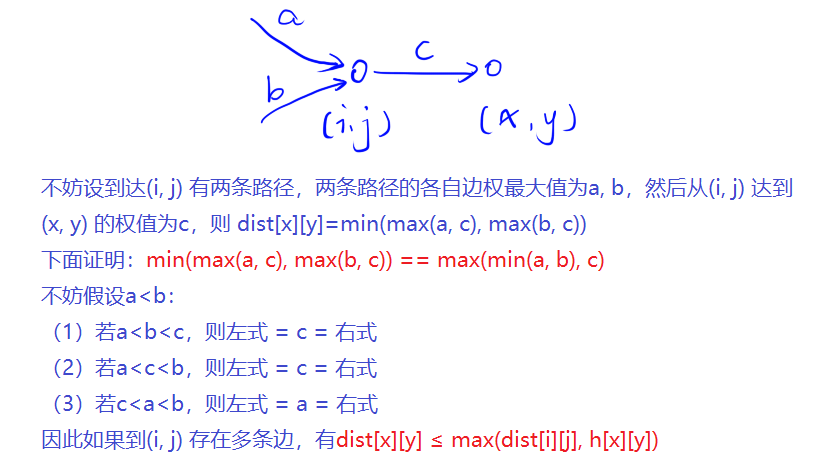分析
-
这里的水只能向上下左右四个方向流动,是四连通的。
-
这一题是Leetcode 0042 接雨水的一个三维版本,而和Leetcode 0407 接雨水 II是一样的,这里认为Leetcode 0042 接雨水是一个二维版本。
-
Leetcode 0042 接雨水只需要求解左右两条路径中的最大高度的最小值即可,这一题的代码如下:
class Solution {
public:
int trap(vector<int> &height) {
int n = height.size();
if (n == 0) return 0;
vector<int> left_max(n), right_max(n);
left_max[0] = height[0];
for (int i = 1; i < n; i++) left_max[i] = max(left_max[i - 1], height[i]);
right_max[n - 1] = height[n - 1];
for (int i = n - 2; i >= 0; i--) right_max[i] = max(right_max[i + 1], height[i]);
int res = 0;
for (int i = 0; i < n; i++) res += min(left_max[i], right_max[i]) - height[i];
return res;
}
};
-
和Leetcode 0042 接雨水的做法类似,我们需要找到从当前位置到达大海的所有路径中的最大值的最小值(从该点到大海有多条路径,每条路径都有一个最大值,我们需要在这些最大值中找到最小的那一个),这个最小值就是下雨后该点的高度。
-
类似于最短路问题,最短路问题是求解路径总和的最小值;这里的问题是求出所有路径中最大值的最小值。这一题可以采用最短路径的方式求解,下面使用
dijkstea算法求解该问题。 -
本题的起点可以设为大海,相当于新建了一个虚拟源点s。从s向四周的每个格子都连接一条边权为0的边,所有起点不能到达的点标记为正无穷,然后从s求单源最短路径即可(从a走到b的边权定义为b所在位置的高度)。
-
代码实现时不需要真实地将s建立出来,直接将s到达的所有点加入优先队列即可。
-
设$dist[i][j]$表示从s到$(i, j)$所有路径中边权最大值的最小值,如果从$(i, j)$能到达$(x, y)$,则根据定义一定有:$dist[x][y] \le max(dist[i][j], h[x][y])$。解释如下:

- 下面还有一个问题,就是要证明一下可以使用
dijkstea算法求解该问题。核心是证明当前从优先队列中出队的元素(假设是$(x, y)$)就是最小值,不可能被其他点更新了。可以用反证法证明,假设当前队首元素会被更新成更小的数据,则一定是被队列中后面的点(假设是$(i, j)$)更新,但是从源点到后面的点的值更大,根据$dist[x][y]$一定是被$max(dist[i][j], h[x][y])$,这里是取大,所以当前队首元素不可能被更新的更小。
#include <iostream>
#include <cstring>
#include <queue>
using namespace std;
const int N = 55;
int n, m; // 行数、列数
int h[N][N]; // 高度
int dist[N][N]; // dist[i][j]表示到达(i, j)的所有路径中边权最大值的最小值
bool st[N][N]; // 堆优化版的dijkstra算法中判重数组, 为true代表该点已经求出答案
int res; // 最终存储水的总量
struct Node {
int x, y, d; // d: 到达(x, y)的所有路径中边权最大值的最小值
bool operator< (const Node &t) const {
return d > t.d; // 默认大顶堆,需要使用小顶堆
}
};
void dijkstra() {
memset(dist, 0x3f, sizeof dist);
memset(st, 0, sizeof st);
res = 0;
priority_queue<Node> heap;
// 将四周的点加入优先队列
for (int i = 1; i <= n; i++) {
heap.push({i, 1, h[i][1]});
dist[i][1] = h[i][1];
heap.push({i, m, h[i][m]});
dist[i][m] = h[i][m];
}
for (int i = 2; i < m; i++) {
heap.push({1, i, h[1][i]});
dist[1][i] = h[1][i];
heap.push({n, i, h[n][i]});
dist[n][i] = h[n][i];
}
int dx[4] = {-1, 0, 1, 0}, dy[4] = {0, 1, 0, -1};
while (heap.size()) {
Node t = heap.top(); heap.pop();
if (st[t.x][t.y]) continue;
st[t.x][t.y] = true;
res += t.d - h[t.x][t.y];
for (int i = 0; i < 4; i++) {
int x = t.x + dx[i], y = t.y + dy[i];
if (x < 1 || x > n || y < 1 || y > m) continue;
if (dist[x][y] > max(t.d, h[x][y])) { // (t.x, t.y)到(x, y)的边权为h[x][y]
dist[x][y] = max(t.d, h[x][y]);
heap.push({x, y, dist[x][y]});
}
}
}
}
int main() {
int T;
scanf("%d", &T);
for (int C = 1; C <= T; C++) {
scanf("%d%d", &n, &m);
for (int i = 1; i <= n; i++)
for (int j = 1; j <= m; j++)
scanf("%d", &h[i][j]);
dijkstra();
printf("Case #%d: %d\n", C, res);
}
return 0;
}

